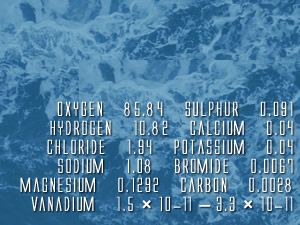The water in the oceans differs from pure water in that seawater has substances dissolved in it. The two most abundant elements in seawater are sodium and chlorine, mostly combined in the form of sodium chloride (common salt); the presence of these elements is the reason for the salty taste of the sea.
Sodium and chlorine, together with four other elements - magnesium, sulphur, calcium and potassium - make up about 95 per cent in weight of the substances dissolved in seawater.
Many other elements also occur in the sea, but are present in very low concentrations. The total volume of seawater is enormous, however, so there is a large total quantity of each element in it. For example, there are about ten million tons of gold in the sea, but in very small concentrations; only about one part of gold is found in each million million parts of seawater, and it cannot be removed easily.
 The concentrations of some of the less abundant elements in the sea vary because they are removed locally by plants and animals. Carbon and oxygen (as carbon dioxide) are two elements that are taken out by green plants because they are necessary for photosynthesis and plant growth.
The concentrations of some of the less abundant elements in the sea vary because they are removed locally by plants and animals. Carbon and oxygen (as carbon dioxide) are two elements that are taken out by green plants because they are necessary for photosynthesis and plant growth.
Other elements in the ocean, such as nitrogen and phosphorus, are essential for plant nutrition. These nutrients are also present in only very small amounts.
The salinity of seawater depends on the amount of substances dissolved in it. Salinity is usually expressed as the weight of the dissolved substances in a thousand parts of water. The ocean has an average salinity of 34.5 parts per thousand (about 3.5 per cent), but this figure varies between 33 and 38 parts per thousand in the open ocean.
Water from rivers or melting ice dilutes sea water, and reduces its salinity. For this reason the water in the Arctic Ocean has a comparatively low salinity, less than 33 parts per thousand. The evaporation of sea water, however, increases its salinity, especially in tropical regions and in seas that are almost enclosed, such as the Mediterranean Sea and the Red Sea, where salinity can be as high as 41 parts per thousand.